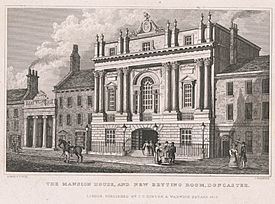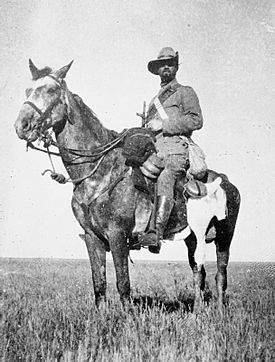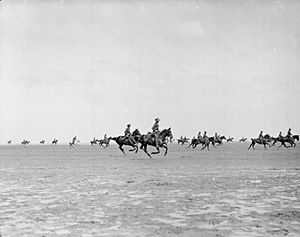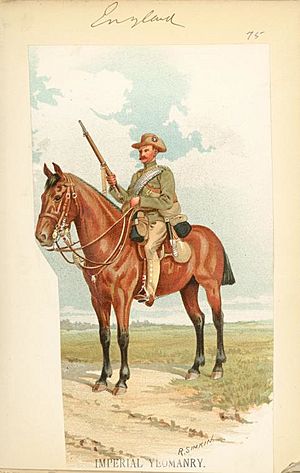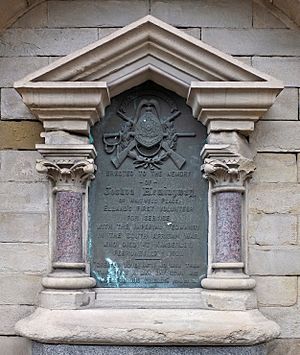Queen's Own Yorkshire Dragoons facts for kids
Quick facts for kids Queen's Own Yorkshire Dragoons |
|
|---|---|
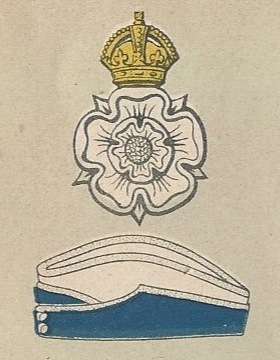
Badge and service cap as worn at the outbreak of the Second World War
|
|
| Active | 1794–1956 |
| Country | |
| Branch | |
| Type | Yeomanry |
| Size | 1-3 Regiments |
| Garrison/HQ | Nether Hall, Doncaster |
| Engagements | Second Boer War First World War |
| Battle honours | See battle honours below |
The Queen's Own Yorkshire Dragoons was a special cavalry unit in the British Army. It existed for a long time, from 1794 to 1956. This group started as volunteer horse riders in 1794 during the French Revolutionary Wars.
The Dragoons played an important part in the Second Boer War in South Africa. However, they didn't get to fight much on horseback during World War I. For a while, they even became a unit that used bicycles!
They stayed a cavalry regiment between the two World Wars. In 1941, they were the very last British Army unit to fight on horseback during the Syria–Lebanon Campaign. They finally switched to vehicles the next year. During World War II, they served as soldiers who moved around in trucks.
In 1956, the Queen's Own Yorkshire Dragoons joined with two other units. These were the Yorkshire Hussars and the East Riding of Yorkshire Yeomanry. Together, they formed the Queen's Own Yorkshire Yeomanry. Today, their history is carried on by A (Yorkshire Yeomanry) Squadron, part of the Queen's Own Yeomanry.
Contents
- How the Dragoons Started: French Wars (1794-1815)
- The 19th Century: Changes and New Names
- The Imperial Yeomanry: Fighting in South Africa
- Territorial Force: Preparing for War
- First World War: From Horses to Bicycles
- Between the Wars: Staying as Cavalry
- Second World War: From Horses to Tanks
- After the War: New Beginnings
- Uniforms and Badges
- Special Leaders (Honorary Colonels)
- Connections with Other Units
- Battle Honors: Recognizing Bravery
- Memorials: Remembering the Fallen
- See also
How the Dragoons Started: French Wars (1794-1815)
When Britain was fighting in the French Revolutionary Wars, the Prime Minister, William Pitt the Younger, had an idea. In 1794, he suggested that counties should create volunteer cavalry units. These units, called the Yeomanry, would protect the country from invasion. They would also help keep order if there were problems at home.
In Yorkshire, a meeting was held in Pontefract. People agreed to form such a force. Another meeting in Doncaster helped raise money for it. On August 13, 1794, two regiments were created. The 1st or Southern Corps of West Riding Yeomanry Cavalry was one of them. This unit later became the Yorkshire Dragoons.
The 1st Corps started with five groups of 50 men each. These groups were in towns like Doncaster, Pontefract, and Rotherham. They trained every month and had a bigger training session once a year. The soldiers helped local police keep the peace in January 1795.
Most Yeomanry units were disbanded in 1802 when there was a short period of peace. But when fighting started again in 1803, the Southern West Riding regiment was reformed. It grew to 12 groups of men. This made it the largest Yeomanry regiment in Yorkshire.
In 1805, there was a false alarm about an invasion. The Southern Regiment quickly gathered with other local volunteers. A politician named James Stuart-Wortley took command in 1810. He led the regiment for 35 years.
The 19th Century: Changes and New Names
After the French wars ended, many Yeomanry units became less important. But the South West York Yeomanry kept going. In the early 1840s, they helped stop the Chartist riots. These were protests by people wanting more rights. New groups of soldiers were added during this time.
In 1844, the regiment was renamed the 1st West York Yeomanry Cavalry (1st WYYC). Some of its groups split off to form a separate unit. Viscount Milton became the Colonel in 1846. He led the unit for 40 years. His family members also served as officers.
In the 1850s, the regiment used the Doncaster Mansion House as their officers' club. They also trained and practiced on the Doncaster Racecourse. In 1871, the 1st WYYC was reorganized into eight different groups.
Over time, the regiment changed its style from Hussars to Dragoons. Dragoons were soldiers who rode horses but could also fight on foot. In 1889, the unit was officially renamed the Yorkshire Dragoons. They started to wear uniforms similar to the 6th Dragoon Guards.
By 1893, the regiment had three main squadrons. A fourth squadron was added in 1894 when another Yeomanry unit was disbanded. The Yorkshire Dragoons, along with other Yorkshire units, formed the 13th Yeomanry Brigade.
In 1897, the Sheffield squadron had the honor of escorting Queen Victoria. After this, the regiment was given a special new name. It became known as the Queen's Own Yorkshire Dragoons.
The Imperial Yeomanry: Fighting in South Africa
The Yeomanry units were not originally meant to fight overseas. But in 1899, Britain faced difficulties in the Second Boer War in South Africa. The government needed more soldiers. So, a new rule was made to allow volunteer forces to serve abroad.
This led to the creation of the Imperial Yeomanry. These soldiers were trained to fight on horseback. The Yorkshire Dragoons helped create the 11th (Yorkshire Dragoons) Company. This company had about 115 men.
The 11th Company and another from the Yorkshire Hussars joined the 3rd Battalion, Imperial Yeomanry. They sailed to South Africa in January 1900. They were the first Imperial Yeomanry unit to arrive. The Yorkshire Dragoons also helped form the 66th (Yorkshire) Company later that year.
The Battle of Boshof
The 3rd Battalion Imperial Yeomanry was part of a larger force. On April 5, 1900, they found a small group of Boer fighters. The Imperial Yeomanry attacked. The Yorkshire soldiers, led by the Earl of Scarbrough, attacked from the left side. They fought like experienced soldiers, even though they were new to battle. This fight, called the Battle of Boshof, was a success for the Imperial Yeomanry.
The Yorkshire Dragoons also helped capture a hill at Rooidam. This allowed them to attack the Boers from the side. The commander, Lord Methuen, was very impressed with their skills. His group became known as the 'Mobile Marvels'.
They marched long distances, protecting the main British army. They also helped rescue other soldiers who were surrounded. The Dragoons were involved in chasing the Boer leader, Christiaan de Wet. They marched hundreds of miles and fought many times.
One officer, Lieutenant Alexis Charles Doxat, won a very brave award called the Victoria Cross. He rode back to rescue a soldier who had lost his horse during a fight.
The war ended in May 1902. The Yorkshire Dragoons earned their first special honor for their bravery: South Africa 1900–02. After the war, all Yeomanry regiments at home became Imperial Yeomanry. They were now called the Yorkshire Dragoons Imperial Yeomanry (Queen's Own).
Territorial Force: Preparing for War
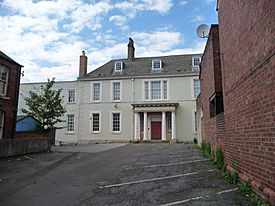
In 1908, the Imperial Yeomanry became part of a new group called the Territorial Force (TF). The regiment was renamed the Yorkshire Dragoons Yeomanry (Queen's Own). Its main headquarters was at Nether Hall in Doncaster.
The regiment had four squadrons, or main groups of soldiers. These were located in Sheffield, Wakefield, Doncaster, and Huddersfield. The Yorkshire Dragoons were part of the TF's Yorkshire Mounted Brigade.
First World War: From Horses to Bicycles
When World War I began in August 1914, the regiment was ready. Many of its members volunteered to serve overseas. Because of this, TF units were split into different groups:
- 1st Line: These soldiers could serve outside the country.
- 2nd Line: These soldiers stayed home for defense.
- 3rd Line: This group trained new soldiers to replace those fighting.
1/1st Queen's Own Yorkshire Dragoons (1st Line)
The 1/1st Yorkshire Dragoons went to France in July 1915. They were split up to help different army divisions. In May 1916, the regiment came back together. They supported the II Corps until November 1917.
They were present at major battles like the Somme (1916 and 1917) and Ypres (1917). Even though they were a cavalry unit, there wasn't much chance for fighting on horseback. Instead, their soldiers often used their machine guns to support the infantry (foot soldiers).
In December 1917, the Yorkshire Dragoons joined the 4th Cavalry Division. They fought in the Battle of Cambrai. This was a big battle where tanks were used for the first time.
In February 1918, the regiment stopped using horses. They became a "Corps Cyclist" unit, meaning they used bicycles. From September to November 1918, they fought with the 9th Division near Ypres.
The war ended on November 11, 1918. The regiment was chosen to be part of the army that occupied Germany. They stayed near Cologne until July 1919. The Corps Commander praised them for their hard work and bravery throughout the war.
2/1st Queen's Own Yorkshire Dragoons (2nd Line)
The 2nd Line regiment was formed in 1914. They stayed in Yorkshire for home defense. In July 1916, many 2nd Line Yeomanry units were changed. Most, including the Yorkshire Dragoons, became cyclist units. This meant they used bicycles instead of horses.
By November 1916, they were called the 7th Cyclist Brigade. In May 1918, the brigade moved to Ireland. The regiment was stationed at Fermoy until the war ended.
3/1st Queen's Own Yorkshire Dragoons (3rd Line)
A 3rd Line regiment was created in 1915. Its job was to train new soldiers. It later joined other training units.
Between the Wars: Staying as Cavalry
After World War I, leaders decided which army units should continue. They realized there were too many cavalry units. Only the 14 most important cavalry regiments were kept as horse-mounted units.
The Queen's Own Yorkshire Dragoons was the 9th most important regiment. So, it was allowed to stay as a horse-mounted cavalry unit. Other units were changed to armored car companies or artillery.
Second World War: From Horses to Tanks
When World War II started, the Queen's Own Yorkshire Dragoons were part of the 5th Cavalry Brigade. This brigade was part of the 1st Cavalry Division.
In June 1941, the regiment was sent to Syria and Lebanon. This was to stop these areas from being used by the enemy. On July 10, a group from the regiment had a small fight with French cavalry. This was likely the very last time British cavalry fought on horseback. The French asked for peace a few days later.
From July to December, the regiment stayed in Syria. On March 1, 1942, the soldiers said goodbye to their horses. The Queen's Own Yorkshire Dragoons became the last active cavalry regiment in the British Army to use horses.
They then began intense training to become an armored unit, using tanks. In May, part of the regiment fought in the Battle of Gazala in the desert. They helped defend a strongpoint called "Knightsbridge." They later helped with camouflage and trick plans at El Alamein.
Because of heavy losses in tanks, the regiment couldn't become a full armored unit right away. Instead, they were given Bren Carriers (small armored vehicles), mortars, and anti-tank guns. They joined the 2nd Armoured Brigade.
The Second Battle of El Alamein began on October 23. The regiment faced many dangers in minefields. On November 2, the line broke, and they chased the enemy.
In January, the regiment fought in Tunisia, attacking the Mareth Line. This attack failed, but they later succeeded in attacking the Akarit Line. The division continued to chase the enemy.
The regiment stayed in North Africa for eight more months. During this time, they changed again, becoming infantry who rode in trucks. They were renamed the 9th (Yorkshire Dragoons) Battalion, King's Own Yorkshire Light Infantry.
In February 1944, the unit was sent to fight in the Italian Campaign. They landed at Anzio. An attack on March 13 caused many casualties for the regiment. New soldiers didn't arrive until May.
On June 3, they led an attack that opened the road to Rome. After more training, they moved to Florence. They fought in the attack on the Gothic Line. Many of the original soldiers who had served for over four years were sent home.
The regiment fought bravely at Coriano Ridge and San Savino, capturing many prisoners. However, there weren't enough new infantry soldiers in the British Army. So, the 18th Infantry Brigade was broken up. The soldiers from the Yorkshire Dragoons were sent to other units. The regiment was put into "suspended animation," meaning it stopped existing for a while.
After the War: New Beginnings
When the Territorial Army was reformed in 1947, the Queen's Own Yorkshire Dragoons started again. They became an armored regiment in the Royal Armoured Corps. They were part of the 8th (Yorkshire) Armoured Brigade.
On November 1, 1956, the Yorkshire Dragoons, Yorkshire Hussars, and East Riding Yeomanry joined together. They formed the Queen's Own Yorkshire Yeomanry.
Uniforms and Badges
The first uniforms in 1794 were red coats with green collars and cuffs. Officers had silver shoulder decorations. They wore white trousers and black boots. Their hats were tall, with a bearskin crest. These uniforms were replaced a year later with shorter red jackets and new helmets.
In 1803, the uniform color changed to dark blue. They wore dark blue trousers and tall brown boots. Their hats were still the Tarleton helmet, but now with a dark blue band. By 1808, their jackets had fancy lacing, like Hussars.
From 1861, the regiment started to change its uniform from the Hussar style. They got new tunics (jackets) and different trousers. In 1862, their fur hats were replaced by a bearskin cap with a white feather. In 1876, a silver Dragoon helmet with a white horsehair plume replaced the fur cap.
When the regiment became the Queen's Own Yorkshire Dragoons in 1889, they adopted the uniform of the 6th Dragoon Guards. This meant a heavy blue Dragoon jacket with white details. They also had blue cloaks for cold weather.
During the Second Boer War, the Imperial Yeomanry wore khaki field uniforms. They had brown leather gear and a Slouch hat with one side turned up. This became the standard uniform for Imperial Yeomanry units after 1901. When they joined the Territorial Force in 1908, the slouch hat was replaced by a peaked cap.
Special Leaders (Honorary Colonels)
These important people served as special leaders for the unit:
- Colonel William Wentworth-Fitzwilliam, 6th Earl Fitzwilliam, from 1886.
- Major-General Aldred Lumley, 10th Earl of Scarbrough, from 1908. He later led the Territorial and Volunteer Forces.
- Lieutenant-Colonel Edward Wood, 3rd Viscount Halifax, from 1935. He was also a very important politician, serving as Viceroy of India and Foreign Secretary.
Connections with Other Units
In 1889, when the regiment became Dragoons, it formed a special link with the 6th Dragoon Guards.
In the 1930s, the regiment also connected with the 8th Princess Louise's New Brunswick Hussars from Canada. This link continues today through the Yorkshire Yeomanry Squadron.
When the regiment reformed in 1947, it was linked to the 9th Lancers, a regular army unit.
Battle Honors: Recognizing Bravery
The Queen's Own Yorkshire Dragoons earned many special honors for their bravery in battles. These are called battle honours. The honors in bold were proudly displayed on the regiment's flag.
- Second Boer War: South Africa 1900–02
- First World War: Cambrai 1917, Courtrai, France and Flanders 1916–18
- Second World War: Syria 1941, El Alamein, Tebaga Gap, El Hamma, El Kourzia, Tunis, North Africa 1942–43, Anzio, Rome, Coriano, Rimini Line, Ceriano Ridge, Italy 1944
Memorials: Remembering the Fallen
There are several places where the Queen's Own Yorkshire Dragoons are remembered:
- In St George's Minster, Doncaster, there are plaques for soldiers who died in the Second Boer War and both World Wars.
- In Elland, West Yorkshire, there is a special plaque for James Hemingway. He was the first volunteer from Elland for the Imperial Yeomanry and died in 1901. The plaque shows the regiment's helmet and badge.
- At York Minster, there is a beautiful stained glass window and an inscription. These remember the soldiers who died in the First World War. The window was put back in 1948 to also honor those who died in the Second World War.
See also
- Imperial Yeomanry
- List of Yeomanry Regiments 1908
- Yeomanry
- Yeomanry order of precedence
- British yeomanry during the First World War
- Second line yeomanry regiments of the British Army


